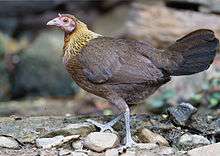Neognathae
Neognaths (Neognathae) (from Ancient Greek neo- "new" + gnáthos “jaw”) are birds within the subclass Neornithes of the class Aves. The Neognathae include virtually all living birds; exceptions being their sister taxon (Palaeognathae), which contains the tinamous and the flightless ratites. There are nearly 10,000 species of neognaths.
| Neognaths | |
|---|---|
 | |
| Female red junglefowl (Gallus gallus) | |
.jpg) | |
| House sparrow (Passer domesticus) | |
| Scientific classification | |
| Kingdom: | Animalia |
| Phylum: | Chordata |
| Class: | Aves |
| Infraclass: | Neognathae Pycraft, 1900 |
| Subgroups | |
The earliest fossils are known from the very end of the Cretaceous but molecular clocks suggest that neognaths originated sometime in the first half of the Late Cretaceous about 90 million year ago.[3] Since then, they have undergone adaptive radiation producing the diversity of form, function, and behavior that we see today. It includes the order Passeriformes (perching birds), the largest clade of land vertebrates, containing some 60% of living birds and being more than twice as speciose as rodents and about five times as speciose as Chiroptera (bats), which are the largest clades of mammals. There are also some very small orders, usually birds of very unclear relationships like the puzzling hoatzin.
The neognaths have fused metacarpals, an elongate third finger, and 13 or fewer vertebrae. They differ from the Palaeognathae in features like the structure of their jawbones. "Neognathae" means "new jaws", but it seems that the supposedly "more ancient" paleognath jaws are among the few apomorphic (more derived) features of the Palaeognaths, meaning that the respective jaw structure of these groups is not informative in terms of comparative evolution.
Taxonomy and systematics
The Neognathae were long ranked as a superorder subdivided into orders. Attempts to organise this group further, as in the Conspectus of Charles Lucien Bonaparte, were never accepted by a significant majority of ornithologists. Until the 1980s, there was little subdivision of the Aves in general, and even less of phylogenetic merit. Since then, the availability of massive amounts of new data from fossils (especially Enantiornithes and other Mesozoic birds) and molecular (DNA and protein) sequences allowed scientists to refine the classification. With new groups of neognath orders being verified, the taxonomic rank of the group needed to shift. Most researchers have now employed the unranked taxa of phylogenetic nomenclature.[4]
The Neognathae are now universally accepted to subdivide into two lineages, the "fowl" clade Galloanseres and the Neoaves (sometimes called "higher neognaths"). The subdivisions of the latter are still not well resolved, but several monophyletic lineages have been proposed, such as the Mirandornithes, Cypselomorphae, Metaves, and Coronaves. Although groups such as the former two (uniting a few closely related orders) are robustly supported, this cannot be said for the Metaves and Coronaves division for which there is no material evidence at present, while the Mesozoic record of Neognathae is at present utterly devoid of birds that should have been present if these proposed clades were real.[5]
Systematics
The orders are arranged in a sequence that attempts to follow the modern view on neognath phylogeny. It differs from the widely used Clements taxonomy as well as from the Sibley-Ahlquist taxonomy, combining those elements from each that more modern research agrees with while updating those that are refuted. Most of the changes affect those "higher landbirds" that are sometimes united as near passerines.[6]
Neognathia
Feduccia defined the clade Neognathia as birds whose palatal mobility increased due to the following modifications (Feduccia 1980, 1996):
Relationships
Neognathae cladogram of modern bird relationships based on Prum, R.O. et al. (2015)[7] with some clade names after Yuri, T. et al. (2013)[8] and Kimball et al. 2013.[9]
Footnotes
| Wikimedia Commons has media related to Neognathae. |
- Field, Daniel J.; Benito, Juan; Chen, Albert; Jagt, John W. M.; Ksepka, Daniel T. (March 2020). "Late Cretaceous neornithine from Europe illuminates the origins of crown birds". Nature. 579 (7799): 397–401. doi:10.1038/s41586-020-2096-0. ISSN 0028-0836. PMID 32188952.
- Van Tuinen M. (2009) Birds (Aves). In The Timetree of Life, Hedges SB, Kumar S (eds). Oxford: Oxford University Press; 409–411.
- Claramunt, S.; Cracraft, J. (Dec 2015). "A new time tree reveals Earth history's imprint on the evolution of modern birds". Sci Adv. 1 (11): e1501005. Bibcode:2015SciA....1E1005C. doi:10.1126/sciadv.1501005. PMC 4730849. PMID 26824065.
- Mindell & Brown (2005)
- For a draft phylogeny of Neoaves that is based on a review of massive amounts of published sources, and probably rather close to "the real thing", see Mindell et al. (2005)
- Mindell et al. (2005)
- Prum, R.O.; et al. (2015). "A comprehensive phylogeny of birds (Aves) using targeted next-generation DNA sequencing". Nature. 526: 569–573. Bibcode:2015Natur.526..569P. doi:10.1038/nature15697. PMID 26444237.
- Yuri, T.; et al. (2013). "Parsimony and Model-Based Analyses of Indels in Avian Nuclear Genes Reveal Congruent and Incongruent Phylogenetic Signals". Biology. 2 (1): 419–444. doi:10.3390/biology2010419. PMC 4009869. PMID 24832669.
- Kimball, R.T.; et al. (2013). "Identifying localized biases in large datasets: A case study using the Avian Tree of Life". Mol Phylogenet Evol. 69: 1021–1032. doi:10.1016/j.ympev.2013.05.029. PMID 23791948.
References
- Claramunt, S.; Cracraft, J. (2015). "A new time tree reveals Earth history's imprint on the evolution of modern birds". Sci Adv. 1 (11): e1501005. Bibcode:2015SciA....1E1005C. doi:10.1126/sciadv.1501005. PMC 4730849. PMID 26824065.
- Mindell, David P. & Brown, Joseph W. (2005): The Tree of Life Web Project - Neornithes. Version of 2005-DEC-14. Retrieved 2008-JAN-08.
- Mindell, David P.; Brown, Joseph W. & Harshman, John (2005): The Tree of Life Web Project - Neoaves. Version of 2005-DEC-14. Retrieved 2008-JAN-08.
_white_background.jpg)
_(6852440498)_white_background.jpg)


_white_background.jpg)

_white_background.jpg)